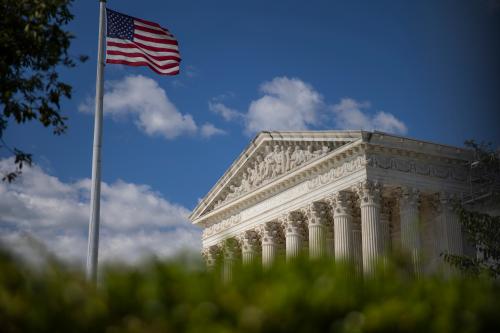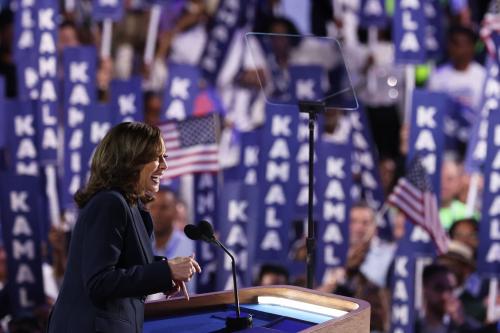1. Can Speaker Ryan extend his honeymoon?
The final weeks of 2015 saw a flurry of legislative activity on Capitol Hill, including the enactment of a five-year highway measure; the reauthorization of the nation’s elementary and secondary education programs; and a massive, two-part bill funding discretionary federal programs through September 2016 and enacting roughly $700 billion in tax cuts. In charting the procedural course of these major legislative initiatives, new Speaker Paul Ryan (R-WI) took a two-pronged approach. On one hand, he claimed credit for using “regular order” when circumstances allowed for a more open process. On the other, he blamed the fact that he inherited a “half-baked cake” from his predecessor when procedural shortcuts were required. In striking this balance, he largely avoided significant criticism from the House Freedom Caucus and their allies, with one member even giving Ryan “an A-plus in trying to reach out to the rank-and-file.”
2016 may not be so kind to Ryan on this front. First of all, several of his procedural triumphs in late 2015, including his ability to open the amendment process on the highway bill and to utilize conference committees, were helped along by contextual factors, like the timing of bills’ consideration and the underlying coalitions that supported them; these circumstances may not repeat themselves in 2016. The greatest potential for meaningful legislating in 2016 likely rests with the appropriations process (see #2), but, as we saw in 2015, open deliberation on spending measures can backfire for the majority party.
In addition, members of the Freedom Caucus have indicated they are likely to cut Ryan less slack in the new year, but will they have the same influence they did in 2015? After all, the debt limit—one of conservatives’ favorite bargaining chips—does not need to be addressed again until 2017. Their principled objection to any spending measures that don’t implement significant cuts—only three of the Freedom Caucus’s members supported the 2015 year-end omnibus—also makes it difficult for them to extract concessions through the appropriations process. Freedom Caucus members could still attempt to keep Ryan procedurally honest through tactics like casting “no” votes on key procedural motions, but the Speaker’s efforts to “return to regular order” in 2016 may well face just as many threats from more mundane factors, like the time pressures of an election year calendar.
2. Will we see separate appropriations bills?
There was no greater source of legislative conflict in 2015 than the appropriations process, including Senate Democrats’ unified commitment to obstructing appropriations measures unless Republicans agreed to relax strict limits on non-defense discretionary spending and then-Speaker John Boehner (R-OH) halting House floor action on spending bills in July after a dispute between the parties over a Confederate flag amendment. Government shutdowns were averted in both October and December, but Congress again relied on an increasingly common tool: the omnibus appropriations package, where some or all of the separate, subject-specific spending bills are rolled together into a single, large bill.
Both Ryan and Senate Majority Leader Mitch McConnell (R-KY), however, have promised that 2016 will be different, with both chambers debating individual spending bills beginning as early as March, an unusually accelerated timeline. One potential roadblock—continued conflict over whether to lift the spending caps put in place by the 2011 Budget Control Act—was removed by the October budget deal, which relaxed the limits for two fiscal years. A promise from Senate Minority Leader Harry Reid (D-NV) not to obstruct the motion to bring appropriations bills to the floor would, if kept, remove a second potential roadblock. Congressional Republicans, however, remain skeptical that Reid will follow through on this commitment, and if the last two presidential election years are a guide, we may well see an omnibus bill just before Congress leaves town for a final campaign push in September.
3. What does a “proposition party” look like, exactly?
Since assuming the Speakership, Ryan has repeatedly expressed his goal of turning the GOP from an “opposition party” to a “proposition party.” In a December speech at the Library of Congress, the Speaker outlined the general themes of an activist House Republican agenda, including tax reform, changes to welfare programs, and the “most urgent”: a viable alternative to the Affordable Care Act. Using the House’s relatively limited election year floor time to enact measures aimed at exciting the Republican base—even if they are headed for probable filibusters in the Senate and near-certain veto threats from the White House—might help Ryan stave off the kind of criticism about failing to advance Republican principles that plagued Boehner and began to percolate outside Washington during the holiday recess. With the presidential race looming large in the background and significant intra-party division on issues like authorizing the use of force against ISIS, Ryan may have trouble successfully pivoting to a policy-focused agenda in 2016.
4. How does Ryan’s vision for the House square with McConnell’s electoral reality in the Senate?
While Ryan attempts to carve out space to debate key Republican policy proposals, Majority Leader McConnell has a very different challenge in 2016: maintaining Republican control of the Senate. Senate Republicans are defending 24 seats to Democrats’ 10 in November 2016, and of the 12 races rated most competitive by National Journal in December, 10 are held by the GOP. Among the most vulnerable in this group are Republican senators from states carried by President Obama in 2012, including Illinois’s Mark Kirk, New Hampshire’s Kelly Ayotte, and Pennsylvania’s Pat Toomey. Forcing senators to vote on whether to bring Ryan’s conservative propositions to the Senate floor, then, could put these vulnerable senators in a tough spot. Kirk, for example, opposed December’s ACA repeal measure over its Planned Parenthood-related provisions. How Ryan and McConnell work together to balance their competing incentives could prove to be an important preview for 2017 if Republicans retain the Senate but a Democrat is in the White House.
5. Will congressional Republicans hand President Obama one last legislative victory on the TPP?
2016 is unlikely to match 2015 in terms of congressional productivity, but one remaining possibility for significant policymaking rests with the Trans-Pacific Partnership (TPP), a major trade agreement among 11 countries by the Obama administration. In June 2015, Congress passed legislation granting it filibuster-proof fast-track status, easing its prospects for eventual ratification. Enactment of the fast-track measure was largely due to Republican support for the broader measure in both chambers; in the Senate, 47 Republicans supported the measure and 5 opposed it, while in the House Republicans split 190-50. By the end of the year, however, Majority Leader McConnell was singing a different tune, claiming that the Obama administration should not submit the now-completed Trans-Pacific Partnership trade agreement to Congress until after the presidential election. Speaker Ryan, meanwhile, remained more sanguine on the deal’s prospects, and President Obama has put it at the top of his legislative agenda for 2016. If congressional Republicans can overcome their hesitancy about handing the president a major victory in an election year, we may see one last addition to Obama’s legislative legacy.



Commentary
2016 in Congress: Five things to watch
January 6, 2016